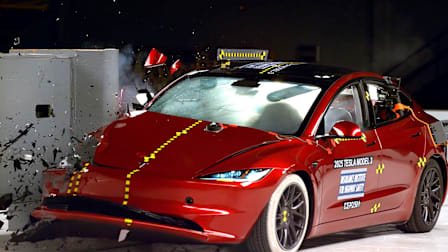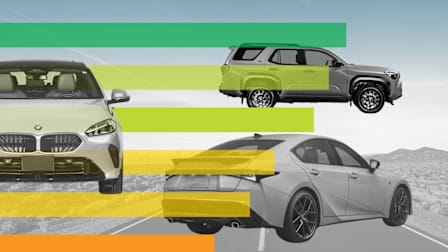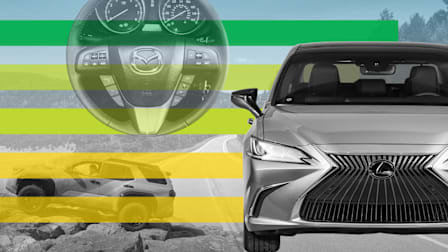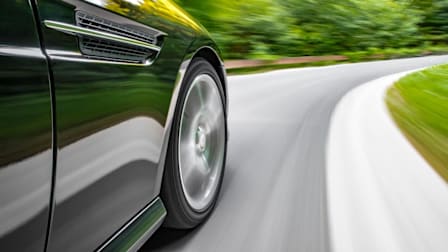ACN: Automatic Crash Notification
Don’t have your phone in hand when you’re in a crash? (Not surprising.) This vital safety system automatically alerts first responders and tells them where you are. (Learn about cars that come with free ACN.)
All-Wheel Drive vs. Four-Wheel Drive
Nope, not the same thing. Both give you traction on all four wheels, but 4WD is more slip-resistant, making it better if you’re driving in muddy places. If you’re mostly driving on pavement, AWD is a better choice. (Learn more about 2WD vs. AWD vs. 4WD.)
Ambient Lighting
Many luxury cars and a handful of mainstream models have LED accent lights in the doors, dashboards, footwells, and even cup holders that you can customize with dozens of color and brightness options to suit your mood—or create one.
Auto Stop/Start
This fuel-saving feature shuts off the engine when the vehicle stops and restarts it when the brake pedal is released. (The switch that turns this system off may be more popular than the feature itself.)
Automatic High Beams
No more guilt because you forgot to turn down your high beams. Cars with this feature switch to low beams when they detect an oncoming car—or even when you’re approaching a vehicle from behind.
EREV: Extended-Range Electric Vehicle
These are EVs with a small gas engine that recharges the battery, giving the car a range that can exceed 600 miles. The retired Chevrolet Volt is a pioneering example; more models are coming to market with this powertrain strategy.
Hands-Free Driving
You can’t buy a driverless vehicle just yet, but some cars can take over the steering, acceleration, and braking long enough to let you open a package of peanuts or a can of soda.
HUD: Head-Up Display
Cool feature that projects speed and even navigation onto the windshield in front of the driver so that they do not need to look away from the road.
ICE: Internal Combustion Engine
Pronounce it the way you do the word that means frozen water. It stands for “internal combustion engine,” and basically it means your car uses gas or diesel fuel. Traditional cars without electrical assist, such as hybrids, are known as ICE cars.
Launch Control
No, this isn’t a feature invented to rocket your car to Mars. It’s a setting in some high-performance models—like the Chevrolet Corvette and Ford Mustang—that optimizes power and traction to deliver blistering acceleration from a dead stop.
Massaging Seats
Some luxury cars—like the BMW 5 Series and the Lincoln Navigator—have pampering seats designed to massage your back with air-filled pouches embedded in the upholstery. What’s next—a shave and a haircut?
Mid Hybrid
These autos offer some electric assist to run an ICE’s electrical accessories, but they don’t compare with regular hybrids in terms of fuel efficiency. (Audi, BMW, Mercedes-Benz, and Volvo make these, and no, they won’t save you much on fuel.)
PHEV: Plug-In Hybrid Electric Vehicle
Plug-in hybrid electric vehicles (PHEVs) bridge the gap between a regular hybrid and an EV. Unlike a regular hybrid, which recharges its battery using only its gas engine and brakes, a PHEV can also be plugged in to add electric-only range, usually between 20 and 40 miles. It can charge overnight from a standard household outlet, so you don’t need to purchase and install a special charger. Once the electric range is depleted, the gas engine provides power for longer trips. If you, like a majority of Americans, tend to drive less than 40 miles a day, you could end up visiting the gas pump just a few times a year. Learn more about PHEVs in our comprehensive buying guide.
Rear-Wheel Steering
Sort of like the second driver steering the back of a long fire truck, this feature automatically turns the rear wheels slightly for tighter turns and easier parking maneuvers.
Turbocharger
Makes a small, energy-efficient engine more powerful (and fun) by force-feeding air into the engine’s cylinders (picture Popeye eating spinach with a leaf blower). Engines make power by burning a mixture of fuel and air. Turbochargers work by forcing more air into the engine when the driver wants more power. That lets the engine burn more fuel and generate more power. The turbo is essentially a fast-spinning fan driven by exhaust gases. The technology allows a smaller engine to generate the power of a bigger engine but only when it’s needed, without the bigger engine’s greater fuel consumption. The downside is that some turbocharged engines hesitate before the turbo spools up and delivers a surge of power.
V2H: Vehicle-to-Home
Electric cars with this capability can send power from onboard batteries to your house during a blackout. No more spoiled food or cold showers when the power goes out (unless you forget to charge your car).
Voice Assistant
This won’t take dictation or make you a cup of coffee, but many new cars have technology that will tell you the weather forecast, provide directions, play your favorite music, and even turn on the heated seats. All you have to do is ask the car.






















